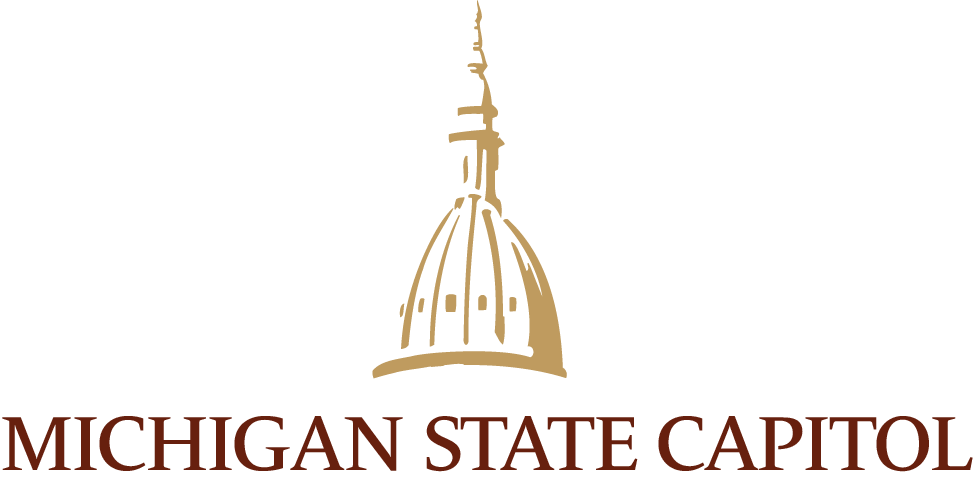
Michigan’s Three Capitols
Lansing was not Michigan’s first capital city. French fur traders and missionaries traveled the upper Great Lakes as early as the 1660s. In 1668, the Jesuit mission at Sault Ste. Marie became the first permanent European settlement in what is now Michigan.
The military post at Michilimackinac was founded a few years later and served for a quarter of a century as the center of French influence on the Great Lakes. Then Antoine de Lamothe Cadillac convinced the French court that a post on the Detroit River would be more advantageous. Detroit, founded in 1701, became the most important settlement in the western Great Lakes region, and remained so even after the British defeated the French in the 1760s.
In 1787, after more than a century of French and British rule, the Michigan region was set aside by the United States government as part of the Northwest Territory. Then, in 1805, Congress created the Territory of Michigan and chose General William Hull as its first governor. On July 1, 1805, Detroit became the capital of the new territory, with various locations in the city serving at different times as the seat of government.
The First Capitol 1837-1847
In 1837, Michigan was admitted to the Union. Through a provision in the Constitution of 1835, Detroit was selected as the first capital of the new state. A territorial courthouse, built in 1823, was pressed into service as the first capitol building.
The 1835 Constitution, however, carried another provision. Detroit would remain the state capital “until the year eighteen-hundred and forty-seven, when it shall be permanently located by the Legislature.” This provision unleashed a firestorm of debate as legislators vied for the honor of locating the capital in their districts.
With Ann Arbor, Jackson, Marshall, and many other cities promoted and opposed for various reasons, James Seymour, a land speculator with considerable acreage in Ingham County, drew attention to Lansing Township. On March 16, 1847, after months of debate in the legislature, the governor signed into law a bill naming Lansing Township in Ingham County the new capitol. Horrified observers, noting that there was not so much as a village at the location, termed it a “howling wilderness.”
The Second Capitol 1848-1878
Nonetheless, the legislature would be required to convene in the new location in January 1848, so there was no time to waste. In late 1847, a wooden structure was hastily erected to serve as a temporary capitol building and a settlement began to rise around it. At first called “Michigan, Michigan,” this confusing name was changed a few months later to “Lansing.” Although it has been Michigan’s capital since 1847, Lansing was not actually incorporated as a city until 1859.
The “temporary” capitol was clearly inadequate from the start. Any thought of a grander building, however, had to be set aside for the duration of the Civil War. Although a 16-foot addition was added to the structure in 1865, it was not until 1871 that Governor Henry Baldwin called for a larger, fireproof, and more dignified seat of state government. The legislature agreed, calling for the construction of a new capitol in Lansing.
The Third Capitol 1879-Present
A board of building commissioners was named, and a nationwide contest was announced to select an architect for the new structure, with a limit of $1,200,000 placed on its construction. In January 1872, a plan (called “Tuebor,” meaning, “I will defend”) submitted by architect Elijah E. Myers of Springfield, Illinois, was selected. Myers moved to Michigan to supervise construction and lived for the rest of his life in his adopted state.
Construction began in 1872. When the cornerstone of the eagerly-awaited building was laid on October 2, 1873, a ceremony was held which rivaled anything Lansing had seen since becoming the capital a quarter of a century earlier. People thronged to the city in numbers far exceeding its capacity. Private citizens opened their homes and made preparations to feed and shelter the visitors.
Materials for the building came from all over the country and even from abroad. Although the millions of bricks that make up its walls and ceilings were locally made in Lansing, the stone facade came from Ohio, the cast iron for the dome and floor beams from Pennsylvania, and the marble and limestone floors from Vermont. The Board of Commissioners made sure the best materials were selected for the best price—wherever they could be found. The final cost totaled $1,427,738.78, considered modest for the construction of a state capitol during this period.








Michigan’s third state capitol was dedicated on January 1, 1879. More than 40 years after Michigan entered the Union, the state finally had a seat of government to be proud of. One of the first to take as its inspiration the just-remodeled national Capitol in Washington, D.C., Michigan’s new statehouse became, in turn, the model for other state capitols. The building’s style, incorporating motifs from classical Greek and Roman architecture, is often termed Renaissance Revival or Neoclassical. Columns in the classical orders—Doric, Ionic, and Corinthian—are found both outside and inside the building and a four-storied central entrance pavilion is flanked by the balanced wings of the House and the Senate. Above the building floats a distinctive, graceful cast iron dome.
Credit to The Jenison Collection at the Archives of Michigan for images of the Capitol construction






